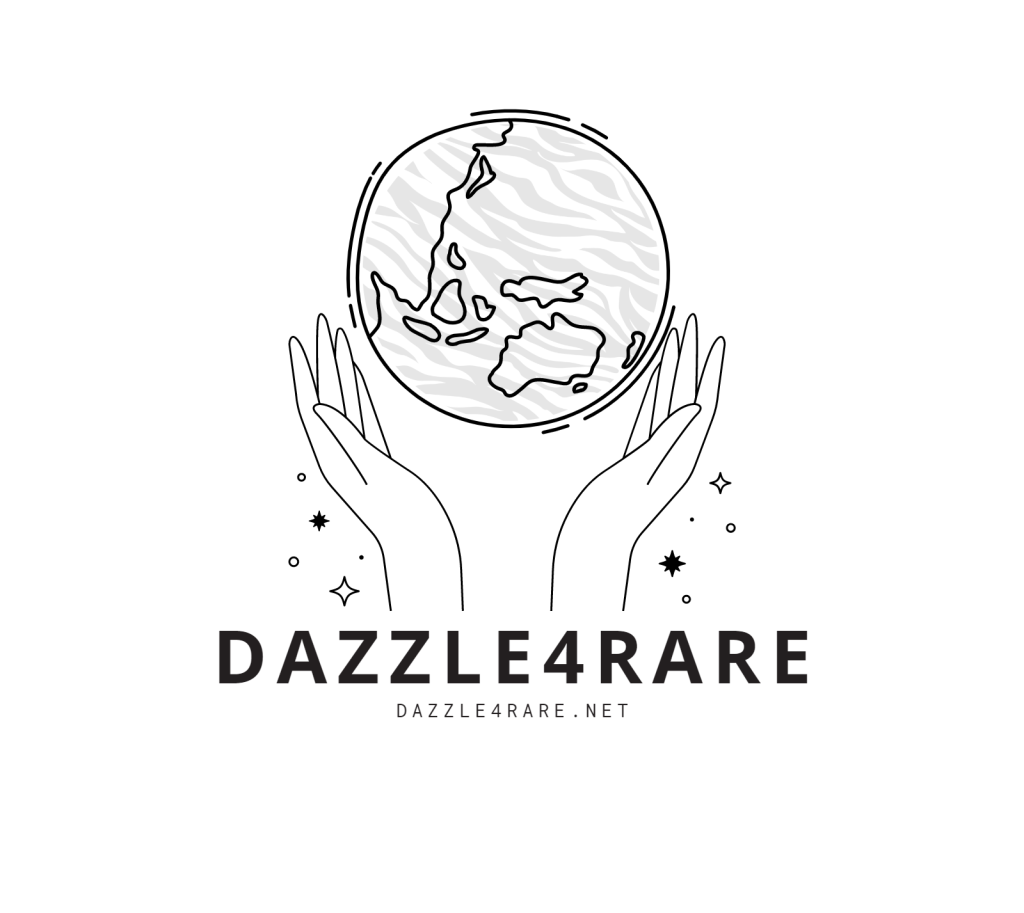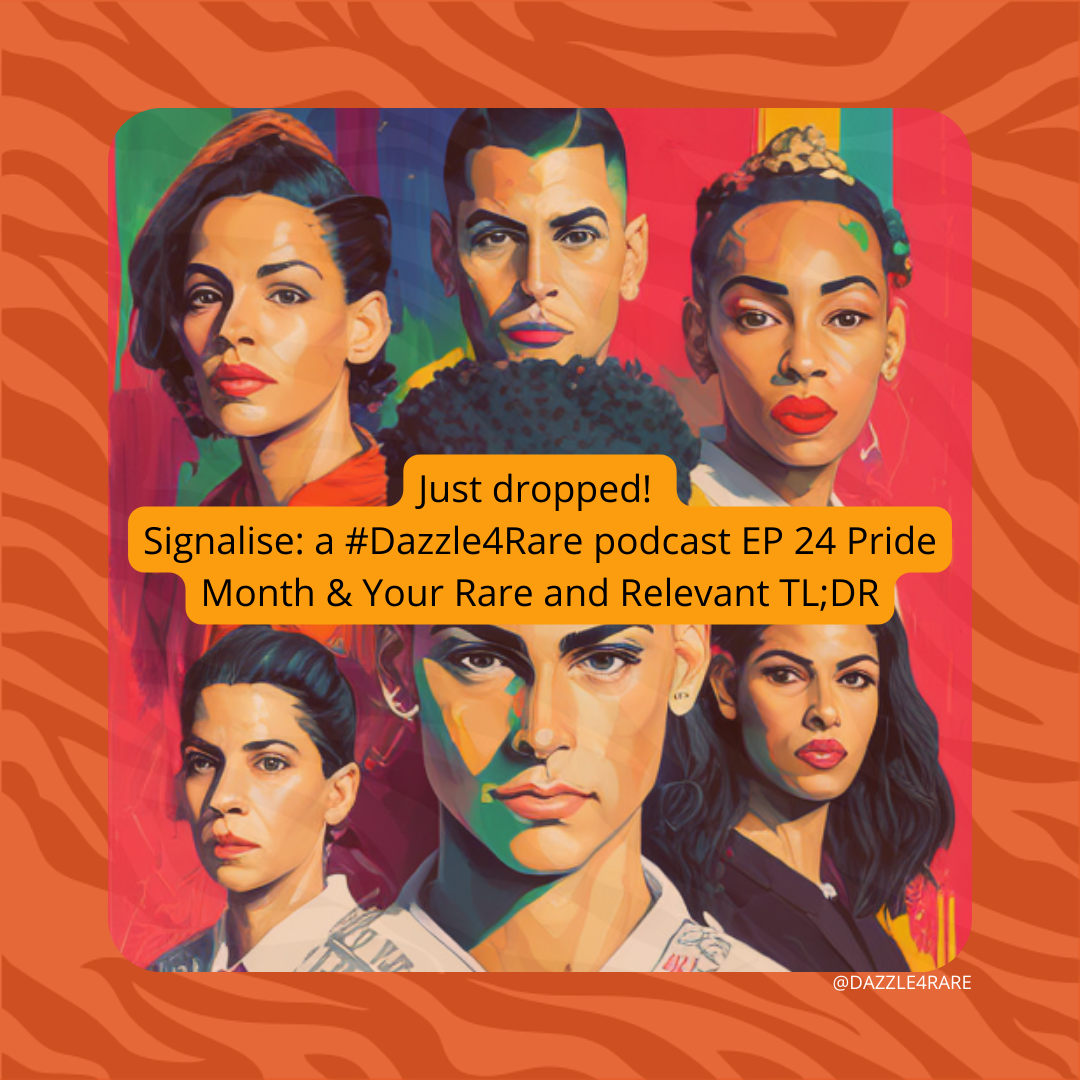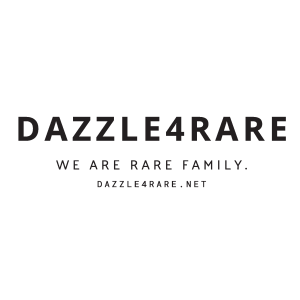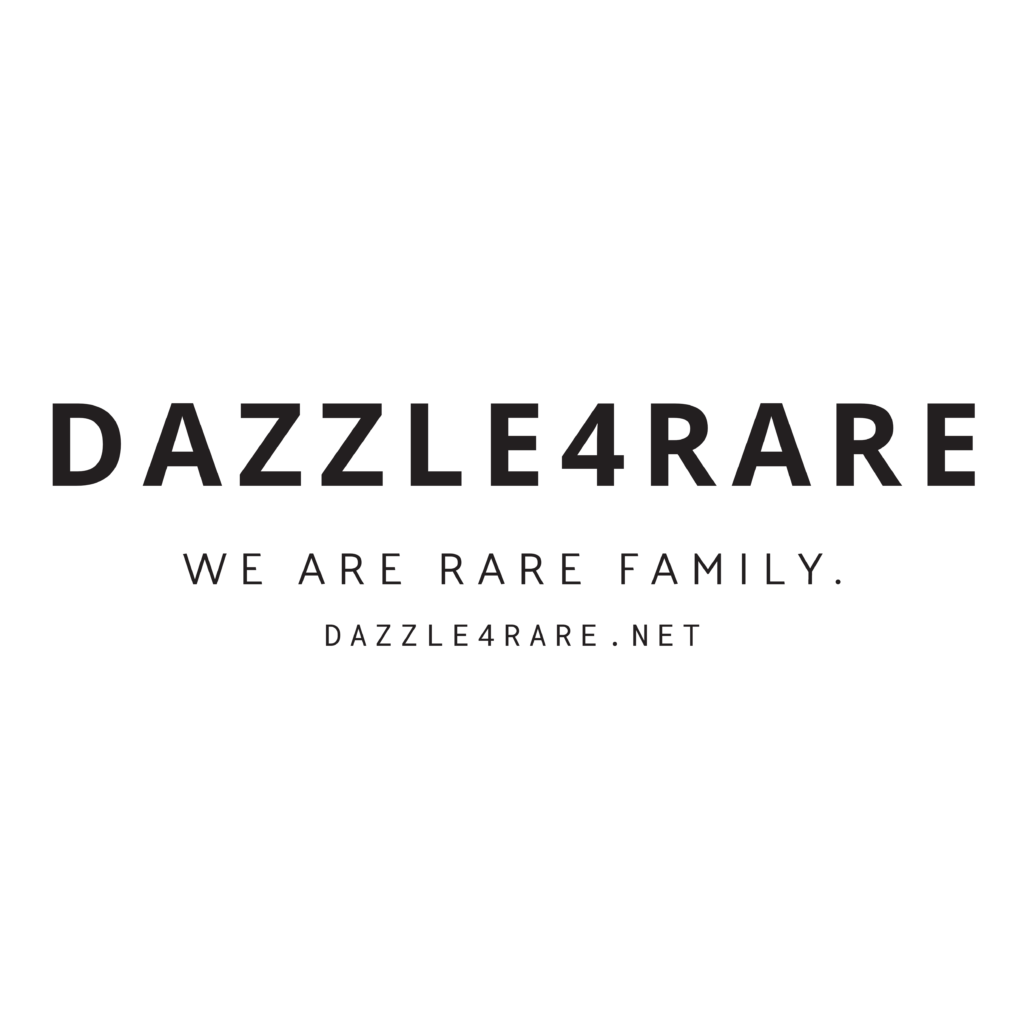Disclaimer:
The below transcript was created with help from Podcastle AI transcription tools. There may be errors or inaccuracies in the below transcript. We’ve endeavored to make corrections but in the interest of time to provide a transcript for the above podcast episode, some errors may persist. Thank you for your understanding as we attempt to make content more accessible to more folks in our communities.
EP 24 Transcript
Hi, I’m your host, Kimberly Thomas-Tague, and you’re listening to Signalize Dazzle4Rare Podcast.
Whether you’re a patient, advocate, caregiver, or a clinician, signalize is your source for good news, personal stories, events, and the things that rare and associated communities care about. Follow Signalize and Dazzle4Rare at DAZZLE, the number four, R-A-R-E on Facebook, Instagram, and Twitter, where we’ll post episode links, updates, and more.
Hey, welcome to another episode of Signalize, a Dazzle4Rare podcast and Happy Pride Month 2023. In today’s episode, we’ll be giving you the rare and relevant TLDR and LGBTQ+ Pride as it intersects with our URCIID, or undiagnosed rare, chronically, and invisibly ill and disabled communities.
Now a quick disclaimer: I acknowledge that folks hold a range of beliefs and ideologies, including those shaped by religion or political affiliations. The intention here is to create a safe and inclusive space for just an open dialogue and for understanding, regardless of these affiliations or beliefs that other folks may hold, understanding that everybody has unique and diverse beliefs. So I’d like to invite you to join us on this journey of learning, empathy, and celebration of the rich and diverse groups that make up our space, which is very special. Pride Month is celebrated globally in June, honoring the LGBTQ plus community’s history milestones and ongoing quest for equality in our global society. Join in the celebration of experiences, resilience, and history. But first, grab a beverage of choice and check out this episode’s rare and relevant TLDR. All right, folks, before we get started with your rare and relevant TLDR for the global, rare, and associated communities out there, let’s hit awareness months, days and events so you can get your calendar sorted. Remember, if you have anything coming up news, events, webinars, you name it. Reach out to us so we can share that here on Signalize. You can also put that information on one of our two calendars, which are available to the public. And now it’s even easier to subscribe to our calendars. Just go to Dazzle4Rare dot Net slash add hyphen calendar, and you can click on a button to add to Google Outlook or download an ICS file. It’s your choice.
So now that we’ve shared that, let’s get into these days. Coming up this month, much of which we covered in the last TLDR. But just to wrap these up and remind you for June, here’s what we’ve got. We have ALS Awareness Month. Canada Antiphospholipid Syndrome or APS CDKL 5 Awareness Month. Dravet Syndrome Awareness Month (US) and Myasthenia Gravis Awareness Month.
A new one that we’ve come across is intrahepatic cholestasis of pregnancy or ICP awareness. You can learn about ICP and what they have on by visiting their website@icpcare.org. According to Icpcare the 1, June is the first day of ICP Awareness Month. Like share and comment to spread awareness, you can support Icpcare 501. During the month of June by registering for their Fun Run. This Fun Run will be their 7th annual where you can run, walk virtually, you can volunteer, you can fundraise, you can donate. Anything that you’re able to contribute for cholestasis of pregnancy would be super helpful to their mission for raising awareness. All right onto awareness days. We have rare chromosome um Awareness Day, which is the 16 June on Friday 2023. We have world sickle cell day on the 19 June, which is a Monday. We have International Dravet Syndrome Awareness Day on Friday, the 23 June. For those who are not familiar with Dravet syndrome, it is an epileptic encephalopathy that often emerges in children. It is related to a rare gene variant. Uh, you can learn more from the EU Dravet Foundation in Spain.
If you are a parent, a caregiver, or a clinician interested in Dravet syndrome, we’d love to talk to you. It’s a topic we would love to cover in this podcast. We’ve reached out to a few folks and not heard back, so please, if you’re interested in representing for the Dravet community, please reach out. Also, we have International Neonatal Screening Day, Wednesday the 20 June. Neonatal Screening is a life changing tool that allows for early detection of rare diseases and timely access to treatment and care. The INSD is an initiative led by the International Society for Neonatal Screening. The ISNs the International Patient organization for Primary Immunodeficiencies or the Ipopi. And, um, the European Society for Immunodeficiencies, the ESID. They’ve been working in partnership with multiple stakeholders to promote the importance of newborn screening. We spoke with Dr. Nicola Garnier in May to talk about newborn screening. 2s Through my work at Pfizer, my engagement with rare disease communities, patients caregivers, advocacy organizations really led me to wanting to do that full time. And so when the opportunity materialized, fully dedicated to patient engagement and patient advocacy, it was really ideal. And um, I have been doing this for the past four years now and really have not looked back. 2s So we will leave a link in the show notes so you can catch up on that episode. It was a great chat and I look forward to having Dr. Nicholas Garnier back sometime soon. Now you can also find out more about International Neonatal Screening Day by checking out their official website which is Neonatal screening Day.
We also have International Scoliosis Awareness Day in South Africa on Sunday, the 25 June 2023. I understand that scoliosis is not rare in and of itself, but there are several types of scoliosis and often they come bundled with other conditions that are rare. Scoliosis can be mild, moderate or severe, but it’s important to understand scoliosis and understand how this spinal condition can affect patients. It requires care and love just like any other comorbidity. Personally, I have dextrokifoscholiosis so Boeing of the thoracic spine and a right curve to the rest of the spine. But many of us in the rare disease communities have scoliosis, so it’s important to be educated about it. Got some more dates for your diary. On the 22nd, we have #medcomms Professionals Day. We talked about this in the last episode.
On the 2 July, there is an episode of AR Arthritis Voices 360 coming up. It is their podcast. The show goes up, I believe, every first Sunday of the month. But if you have any doubts, you can reach out to talk show@aiaarthritis.org and you can always find them on your podcasting app of choice so you can check out their fantastic podcast. As of the date of this podcast, the 7 June Beacon for Rare has a webinar on called Managing Expectations of Advanced Therapies. It sounds really fascinating. If you missed out on this one today, make sure you check out Rarebeacon.org events calender. To stay up to date, we’ve added, uh, some of the events to the Dazzle4Rare calendar, which, as I said at the top, you can get on iOS, Android, laptop, desktop, mobile, whatever you’ve got, just go to dazzleferre. Net. We have buttons, you can click on it’ll, add it to your device. It is like magic.
Now we have some in person events and conferences. Don’t worry, guys, we’re keeping it short so we won’t bore you to tears. The Third Pediatric Experts patient training workshop. Are you a teenager aged twelve to 18 with an interest in health or biomedical research? If you are, thank you for listening to this podcast, Dang. We really appreciate it. If you’re not and you’re the parent of a teenager twelve to 18, check it out. You can join the Third Pediatric Expert Patients Training Workshop, organized by the Teddy Network in collaboration with EURORDIS, the European rare diseases organization. This is happening at the hospital Sanjon de Di. You can become a contributor to scientific research and improve healthcare services and outcome for all patients. This is an in person event happening in Spain, so if you want more information, there will be a link in the show notes. Also, we have coming up the World Without Disease Summit from our friend and friend of the dazzling general, Carol Scrafton of Flutters and Strutters. According to the website, Pharma Forum is proud to announce its inaugural the World Without Diseases Summit, a high quality two day event bringing together key global leaders and innovators to explore the potential of disease interception in future health, which has been conceived in partnership with an established industry leader in the space. Ben Wygand, founding partner at CWWDA, the connected world without disease accelerator. He’s also the former senior executive at UnitedHealth and Janssen. The World Without Rare Disease Summit recognizes the health systems globally have reached a critical inflection point where aging populations and tightening budgets mean we can no longer continue to purely treat late stage symptomatic disease. Absolutely agreed. Instead, a new paradigm is needed where equal emphasis is placed on earlier disease prediction, prevention and interception, which can deliver vastly improved outcomes for patients in a much more sustainable manner. Delivering on this vision requires strong collaboration between multiple stakeholders. Within the industry and health systems, most notably those addressing the clinical, regulatory and investment challenges that must be addressed to realize this opportunity. This is the vision of the world without disease, which necessitates bringing together key stakeholders plus the latest medical and digital technologies. Join the folks on the 21 June 2023 in London where, as their website states, the smartest minds in the field will convene to understand how we can bring this vision to life. Gosh darn, it sounds like a great vision to me and I hope it sounds great to you too. Thanks so much to Pharma Forum for putting this together, as well as Paul Tuna. You can find information in the Show Notes.
Continuing on, we’ve got a little bit of industry stuff here. The Applied Clinical Trials and IQVIA are putting on an industry webinar on the 22 June called Tech Integration and Automation that simplifies site and patient experience. And as patients I think that’s something we would love. We would love to see a simplification of onsite and virtual and decentralized trial experiences. So very cool. Uh, here’s what they have to say about the event implementing clinical technology strategies that improve data quality, reduce site effort and optimize workflows is more important than ever. Amen. Uh, in addition, the sharp rise in investigational, product, IP and shipping costs is crucial to take the integrated platform approach, including advanced drug supply tools that optimize trial supply and support sustainability goals. When sponsors invest in best of breed solutions that leverage intelligent integration and workflow automation, it is possible to support both a positive technology experience for its sites as well as the optimization of the clinical supply chain. In this webinar, IQVIA experts will share how to utilize integration and automation strategies to maximize trial efficiencies, reduce costs and align with sustainability goals. It sounds amazing. So if you are so inclined, we’ll put a note in the Show Notes for you to check that out.
And our final bit of industry related news is Australian Genomics. If you are interested in genomics, the folks from Australian Genomics are putting together a webinar called Diagnostics of Rare Diseases Beyond the Exome. Again, sounds really cool. This is happening on the 29 June. According to Australian Genomics, the genetic causes of rare disease will not be found in about 50% of patients. When applying whole genome sequencing, diagnostic, short and long read genome sequencing, transcriptome sequencing and epigenomics are the next steps to increase diagnostic sensitivity. Rare disease patients are also at risk of common diseases. Very true. Common disease prevention and prediction, therefore, will also play a major role in the future of health management for rare disease patients. Again, we’ll leave a registration link in the Show Note for those so inclined. All right, now on to what is up in the rare and associated spaces. Y’all. Again, like I’ve said before, if you have news or events that you want to share, you can send those to me at Kimberly@dazzleford.net and put Signalize in the title.
So I know what we’re we’re talking about. The MHRA and Genomics. England are going to. Help folks better understand how genetics influence medication safety. The MHRA, also known as the Medicines and Healthcare Products Regulatory Agency and Genomics. England are launching something called the yellow card biobank. This is a genetic research resource to understand how patients genetic makeup affects medication safety. The Biobank will contain genetic data and patient samples, enabling scientists to identify genetic traits linked to adverse drug reactions. By using rapid screening tests, personalized medicine can be achieved, providing patients in the UK with the safest medications based on their genetic profile. The adverse drug reactions contribute to a significant burden on the NHS, accounting for one in 16 hospital admissions, the Yellow Card Biobank aims to reduce side effects by utilizing high quality patient data. The pilot phase will begin on the 1 June 2023, with participant recruitment starting on the 1 September. For more information on this, you can go to Gov uh, UK Government News. This collaborative effort between the MHRA and Genomics England seeks to redefine drug safety by gaining a deeper understanding of genetic influences on adverse drug reactions. Health and Social Care Secretary Steve Barkley recognizes the strain these reactions are having on the NHS and highlights the potential chill of genomics research such as the Yellow Card Biobank to enhance patient care and outcomes. The initiative aligns with UK’s Life Sciences vision, harnessing genomic capabilities to deliver safe and effective medications.
Next, we have really interesting story about a Dutch gentleman named Hert Jan Oxem. He is a gentleman who was paralyzed in a cycling accident back in 2020. Back in 2011. He has recently regained the ability to stand, walk and climb stairs with the help of something called a digital bridge or a brain machine interface. This interface was developed by Neuroscientists in Switzerland, enabling the device to read his brainwaves and communicate to his spinal cord, activating the appropriate muscles through implanted electrodes in his brain and spine. Herteon’s intention to move is decoded and translated into stimulation, enabling voluntary leg movements. While the technology is very much in early stages, researchers hope that miniaturized devices like this will aid stroke patients, people with paraplegia and individuals with spinal cord injuries, potentially facilitating movement of other body parts as well. Next up recently, a couple articles have come out talking about early signs of multiple sclerosis. Multiple sclerosis is a chronic condition characterized by nerve damage in the brain and spinal cord. Early signs of MS can be nonspecific and easily mistaken for other conditions. However, there are three specific early signs that folks can be aware of. One is optic neuritis, blurry vision or pain in one eye, potentially swelling. There is something called la uh, Lahermetz sign. I hope I pronounce that part properly. It’s an electrical shock like sensation down the spine when bending the neck and transfer. First myelitis, which is reduced sensation or numbness in limbs, limb weakness, possible bladder or bowel dysfunction. These symptoms can also be caused by other factors, so it’s important to consult your doctor to determine the underlying cause, especially if you have any of these three symptoms. Diagnosing Ms can be very challenging and can take several years. And specialists need to conduct various tests such as brain and spinal cord scans, blood tests, and sometimes lumbar pulp, which, from experience, not the most fun I’ve ever had. Although there is no cure for Ms, there are over 20 medications able to manage symptoms and slow down disease progression. Treatment approaches can include medications, steroids during acute phases, nonpharmaceutical approaches like physical therapy, speech therapy, and lifestyle changes. Early diagnosis and coordinated care can help limit and slow the damage caused by MS enabling individuals to lead full lives. All right, a few, uh, little bits and bobs here from Global Genes that are coming up in September. I’m mentioning it now because if you’re anything like me, you’ll see the email or you’ll see something go, oh, yeah, that’s right, I want to attend that, or I need to mark that on my calendar. And then you just won’t.
Hopefully, if you’re listening to this podcast, this is your reminder to mark it on your calendar. Let’s not fool ourselves. Time flies. The Rare Health Equity Forum has announced its upcoming event focused on promoting health equity within the rare disease community. The Forum brings together stakeholders in the rare disease spaces to address the biases, barriers, and challenges faced by marginalized populations. The theme is equity in action. This year’s event aims to provide attendees with practical tools and strategic insights to support underserved and underrepresented patients. The forum will take place on the 18 September to the 19th at the Sheridan Harbor Island in San Diego, California. Keeping with this theme for Global Genes, get ready for the Rare Advocacy Summit hosted by Global Genes, where individuals from rare disease communities all over can come together to connect, inspire, and learn. This annual event brings together rare disease patients, caregivers advocates, healthcare professionals, researchers, partners, and allies who from around the world. Participants will have the chance to establish meaningful connections for future collaborations while gaining insights into the latest innovations in rare disease and best practices for advocacy. The summit, taking place from the 19th to the 21st, will be held at the Sheridan San Diego Hotel and Marina in San Diego, California. Don’t miss this opportunity. You can network, learn, and get inspired to accelerate positive change. So there will be a link to register or a link to more information in the show notes.
All right, folks, now we’ve come to the segment of the podcast where we will talk about the Origins of Pride Month. So, for my fellow history buffs, Pride’s origin story really kicked off with the Stonewall riots in June of 1969. Hence why we’re celebrating in June the riot erupted when a police raid at the iconic Stonewall Inn, a gay bar nestled in New York City, erupted. Activists Marcia P. Johnson and Silver. Via Rivera emerged from the events that took place at and after Stonewall in 1969 as leaders in the gay liberation movement. Together, they went on to help found organizations and take actions that offered housing to homeless and transgender youth who were then, and still are, a vulnerable part of our society. So fast forward to the next year when the first Pride March kicked off in various cities, including the monumental Christopher’s Street Liberation Day, which was a march in New York City.
These marches were a powerful way to honor the Stonewall riots and champion the causes of LGBTQ plus equality. Initially more of a protest than a party, these marches played a crucial role in shedding light on the unseen diversity inclusivity of the LGBT community. However, let’s not forget that transgender women and people of color still faced exclusion during these early years, despite the role they played in the original Stonewall riots. Thankfully, as the movement gained momentum around the world, more individuals from diverse backgrounds found a place of belonging and joy in the greater LGBTQ plus communities.
While this statement is a bit overstated in kind of a cringy way, it’s true that representation does really matter. I know it gets used. That statement gets used a lot, but it’s true. Let’s chat about some of the areas where the undiagnosed rare, chronically, ill and invisibly ill and people with disabilities communities intersect with the LGBTQ plus communities. Of all the things that I have personally admired about Pride during my four decades on this planet is the way that the gay and lesbian communities of the for a common goal. While it started as a way to survive and thrive and genuinely live their lives during that time period, it was also, in some ways, a, uh, glimpse of the future for other communities, such as communities of color, and what could be achieved by working together and seeking visibility as a larger group. Not just one small group each.
Do you see where I’m kind of going with this?
Before we get going let’s just talk about the acronym that I just used a moment ago, the URCIID.
I got this idea because of groups like the LGBTQ plus Community, the BIPOC Community, or Black Indigenous People of Color Community, and other communities that use similar acronyms. URCIID stands for undiagnosed rare, chronically and invisibly ill and disabled humans or people. Whatever you prefer. We are, at the end of the day, all humans.
I came up with the acronym a couple of years ago. Like I said, because of similar acronyms, and often talking about our community is something greater than just the rare disease community. It feels like a lot of folks kind of push back a little bit on combining the efforts of rare communities with other communities, such as communities that share comorbidities with us.
As I said earlier, Scoliosis isn’t rare, but a lot of people with rare conditions have Scoliosis, we can find community and support and commonalities between rare conditions that have Scoliosis and Scoliosis communities. And that’s something that’s that really gives us strength rather than separating us. I think so. The LGBTQ community has always been inspirational to me in that way, and their ability to see common struggles to unite and then make impactful social change. It’s taken decades to do so, but in the last 50 years or so, the greater community has accomplished a lot. If the LGBTQ communities were able to inspire and show a potential way forward to communities of color and other groups of people, why couldn’t we do the same as we seek equal and inclusion in society and in the medical care system?
As time went on, things went from gay and lesbian to gay, lesbian, and bisexual. The acronym, once it was created, once it was a way of identifying a group of folks, it went from just being gay and lesbian to gay, lesbian, and bisexual. It further evolved to include transgender folks and now includes nonbinary folks and other queer identities. What I’ve seen since the 90s is the evolution of inclusion. I used to volunteer at the LGBTQ plus community center in Tucson, Arizona, in the 90s. Back then, it was just the LGBT community, and I proudly helped serve the community of southern Arizona. At the time, the tea in LGBT was underrepresented, and it kind of felt like and I think we thought at the time that we had the only trans individual in Tucson at the center on the weekends. It was a fun place to be, and I’m glad for the time I spent volunteering there.
As time marched on, the community became more inclusive and more self aware. Welcome people of all ages, identities, ethnicities, and levels of ability. How does it affect you or I or anyone else being part of the URCIID community?
If you intersect with the LGBT community and their visibility, it can help folks with rare conditions connect with other folks who share similar lived experiences. Being part of both communities, LGBTQ+ and rare, undiagnosed, et cetera. There’s a bigger family of support out there for those who intersect between these communities. We can share our stories as folks who exist in both communities to increase awareness about the unique challenges in life. For some folks, for instance, being gay and disabled or being trans and having a rare condition, you might laugh at this idea of intersectionality, but there is a very popular trans gamer on YouTube named Stephanie Sanjatti, and she’s done a great job on YouTube sharing not only her transition journey, but her rare condition, Waardenburg syndrome. It is possible to identify in more than one category. In fact, many of us occupy several spaces in society as people who are patients, people who are scientists, people who are also gay, lesbian, transgender, queer, et cetera, people of color. We’re often not one thing. We’re often a variety of things. Sharing experiences that unite these different parts of us help put a face on the unique struggles that we face.
Another piece of this is both of our groups at large and representation in the media. Having LGBTQ plus individuals with rare diseases represented in mainstream media, such as documentaries, films, news articles, helps to increase visibility and representation. This representation can stigmas, promote acceptance, and amplifies people’s voices. Again, we’re often. Not just one thing in life, not just someone with a rare condition. And that’s all we are seeing. Folks from all different sides facing unique challenges that exist because of this intersection helps others to see that actually these people aren’t just outliers, we aren’t just rare, but we are people in their communities as well. We can also collaborate and partner with folks in our communities. And I’m not sure why we haven’t really done this as a greater rare and associated condition community, but if we were more effective and strategic about opening up about our intersectionality, the intersections of race, sexuality, gender, expression, health status, we could improve our visibility and keep reaching more people through these logical collaborations. Imagine m reaching more people with within the LGBTQ+ community through your story of rare disease and your intersectional identity and people of all ages that you could reach, giving them a face to identify with and to empathize with. We could be creating more powerful alliances with the LGBTQ+ and other communities, such as the BIPOC communities and other communities in places where we genuinely intersect. The last point here in this is that policy and health care reform is also something that is intersectional and affects all of us. There are going to be health care needs that are not well understood or well addressed in the LGBTQ+ family or community who also have rare conditions or who are facing a lack of diagnosis. I like to think that our tent is big enough to welcome the LGBTQ+ community to talk about their experiences as people who are undiagnosed rare, chronic invisibly, ill or living with a disability and vice versa. We don’t have to just be one thing. We can authentically be ourselves while also being part of different groups, creating strength in numbers and a place where we’re celebrated for our uniqueness and not ostracized. So together, I think we can bring the needs of the LGBTQ+ community in with the rare and chronic health care and disability rights actions that we’re taking. We can work together to make change in healthcare systems that make sense and isn’t based on the assumptions of people who don’t identify as URCIID or LGBTQ and those who are making these assumptions based on a lack of visibility in our communities to the wider world. We can strive for more inclusive policies and legislation, ensure that health care providers are providing care that respects our cultures, religions or lack thereof, and the work to lessen and one day eliminate discrimination in our healthcare services.
I know it’s a statement that we hear all the time that representation matters. But visibility and representation for LGBTQ Plus folks with rare diseases can be a powerful catalyst for a sense of belonging and a sense of community. Sharing personal stories and experiences can raise awareness about the unique challenges faced by these folks and that challenge the stereotypes and promote understanding. Collaborations and partnerships with LGBTQ+ patient groups, rare disease advocacy groups and healthcare professionals can help create alliances to drive policy health care reform. We can create a culturally competent care system, and we. Can have access together, through media representation and other types of representation, we can amplify each other’s voices, challenge stigmas and false beliefs, dispel people’s fears and to promote acceptance. Ultimately, by embracing visibility and representation, we create a more inclusive society, breaking down barriers, supporting people’s wellbeing, and supporting folks in the LGBTQ+ community who also have rare conditions or chronically ill invisibly ill or a disability in advancing healthcare equity for all of us. I hope you enjoyed this episode.
If you have other news items, please feel free to reach out. 2s Thanks for listening to this week’s episode of Signalize a Dazzle4Rare podcast. To stay up to date on the podcast and Dazzle4Rare follow us on Facebook, Instagram and Twitter at D-AZ-Z-L-E, the number four, rare R-A-R-E and finally, if you liked this episode, share it with a friend and tag us on social media platforms.





